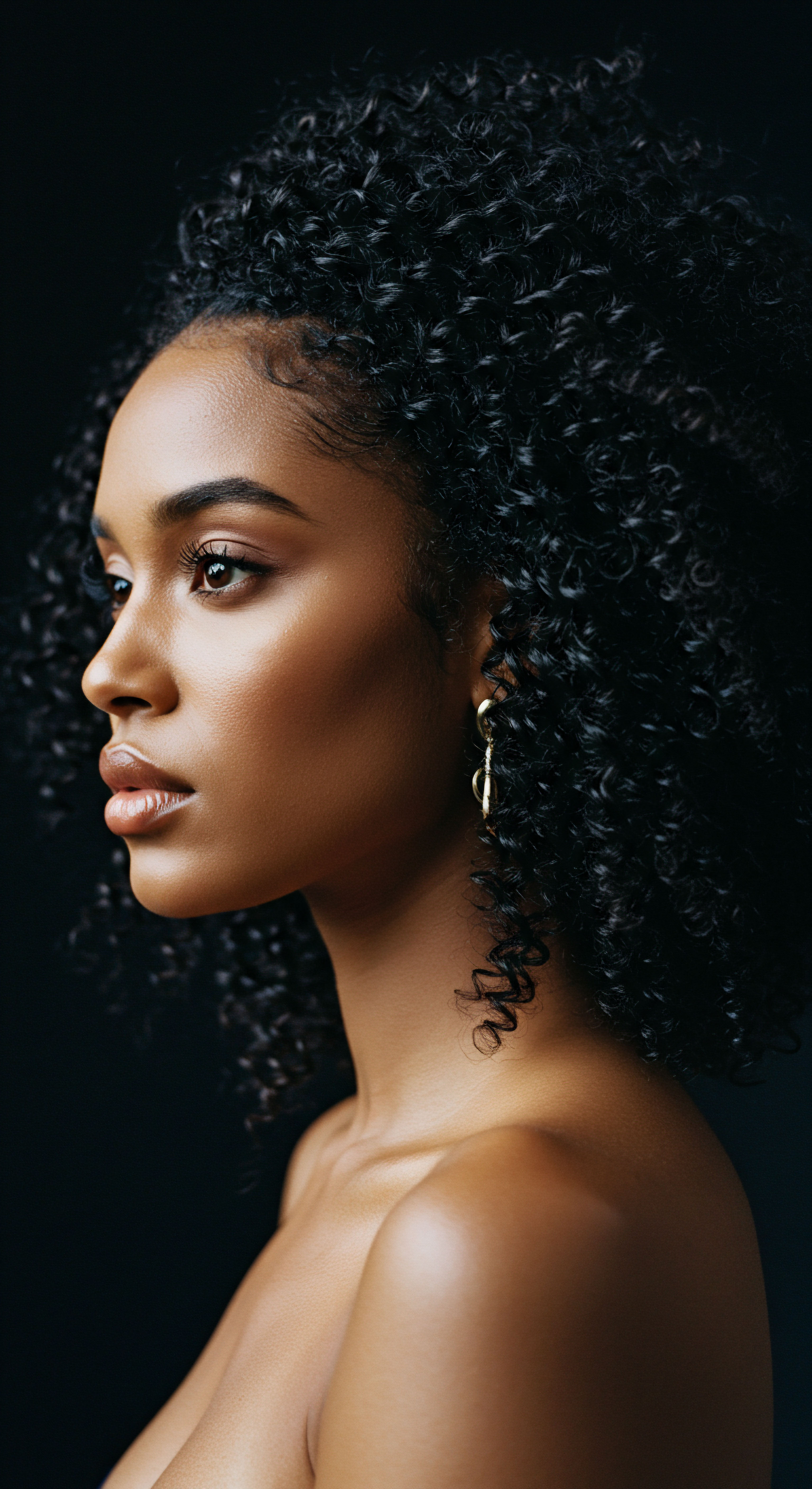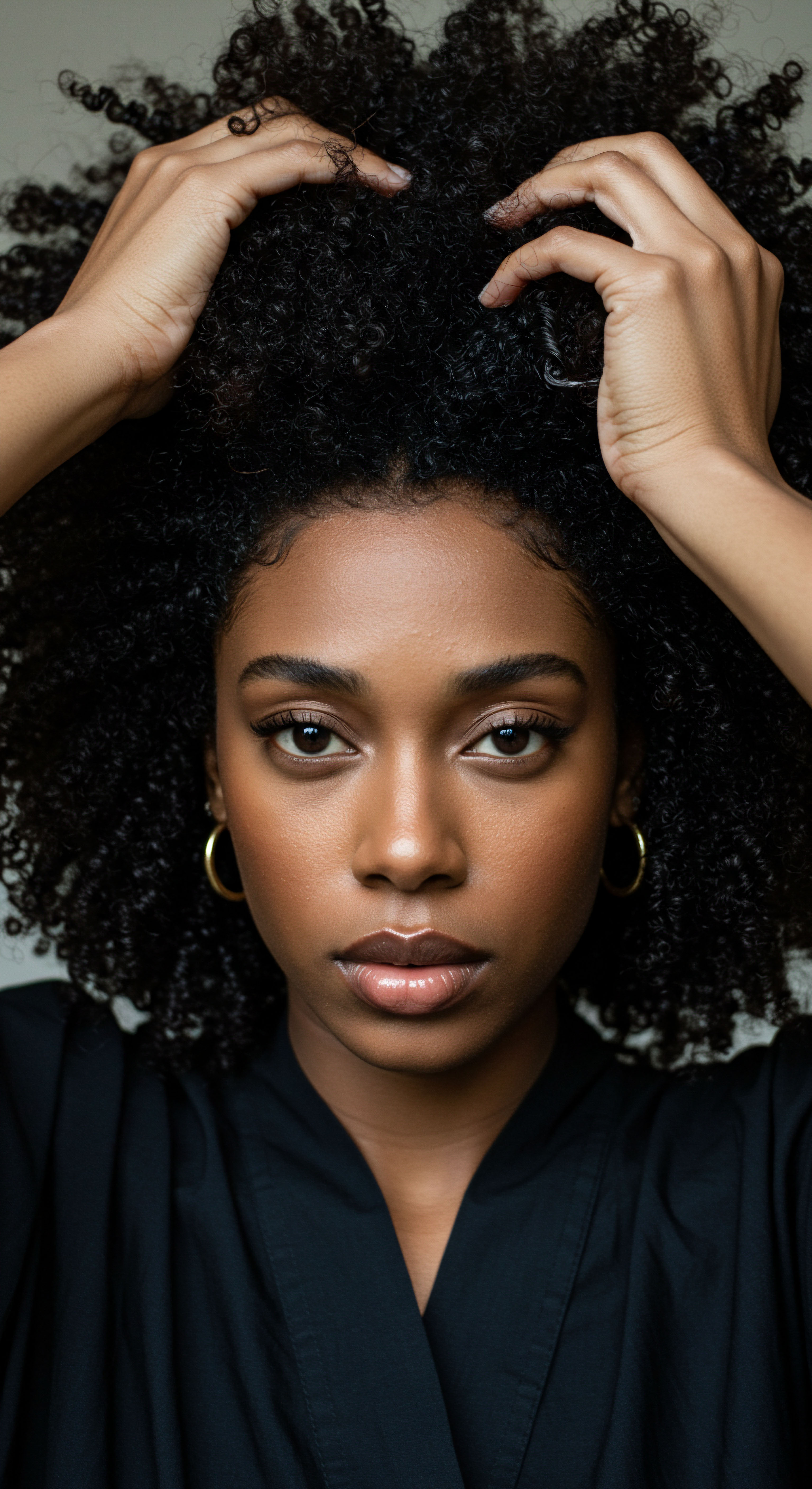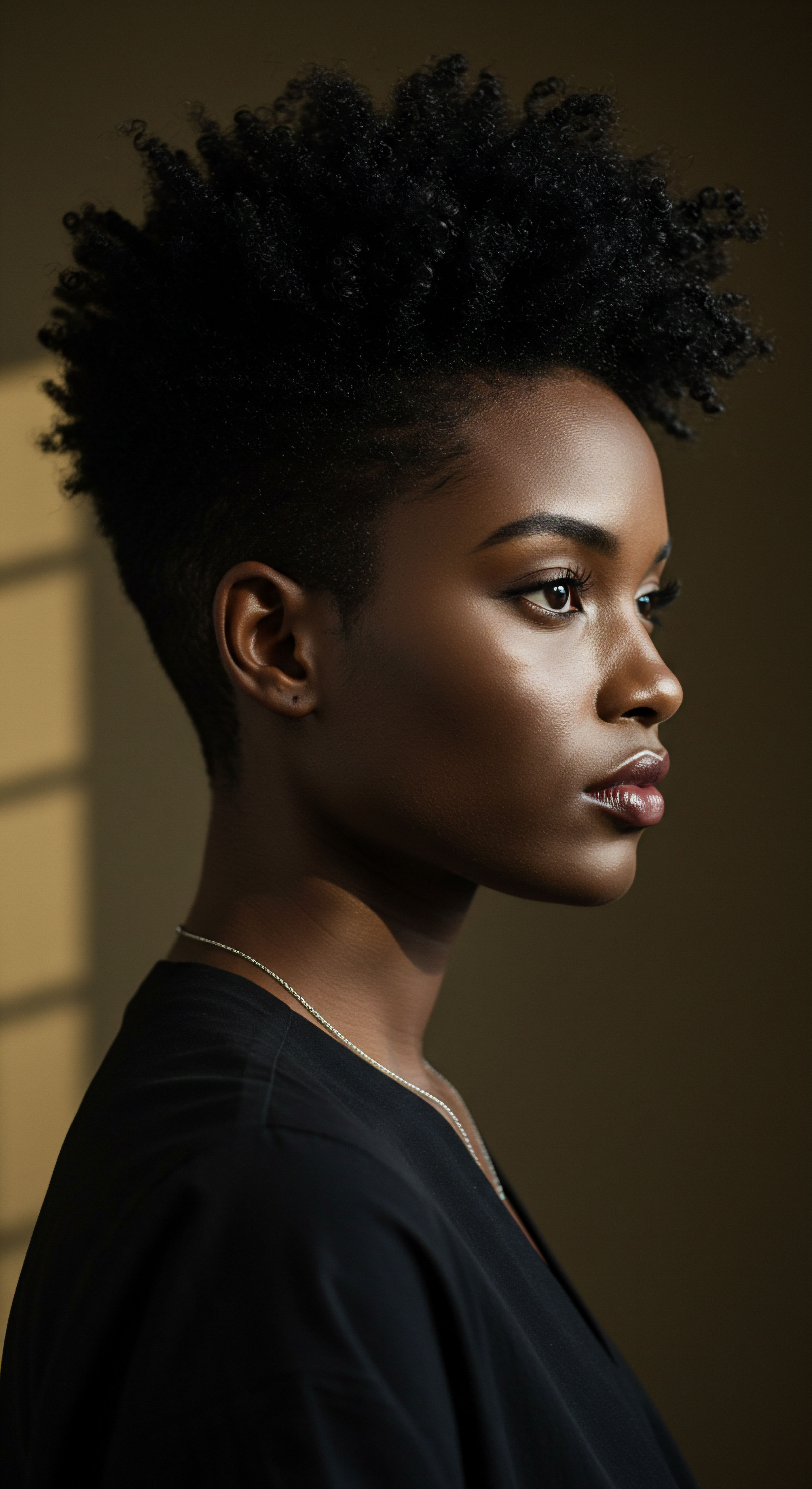
Roots
The quiet hum of daily life often masks the subtle interactions shaping our very being, even down to the delicate strands that crown our heads. We often consider hair a given, a part of us that simply exists, yet its well-being is a testament to countless moments of contact, movement, and environmental interplay. The question of whether long-term friction truly influences hair growth and density beckons us to peer beyond the surface, inviting a deeper connection with the very foundations of our hair’s vitality. It asks us to consider not just what we see, but the unseen forces at play, much like the roots of a mighty tree that quietly sustain its outward splendor.

The Architecture of a Strand
Each individual hair, whether a fine whisper or a robust coil, stands as a testament to biological marvel. At its core, hair is a protein-based biomaterial, primarily composed of keratins, which are fibrous, cysteine-rich proteins. These proteins arrange themselves into intricate structures, giving hair its strength, elasticity, and unique shape.
The hair shaft, the visible part of our hair, emerges from the scalp, rooted within a tiny organ known as the hair follicle. This follicle, nestled beneath the skin’s surface, acts as the living factory of hair, dictating its growth, texture, and overall health.
The outermost layer of the hair shaft, the cuticle, resembles overlapping scales, much like shingles on a roof. These scales, when healthy and lying flat, shield the inner cortex from external harm. Beneath the cuticle resides the cortex, which provides hair with its mechanical strength and houses the melanin responsible for color.
At the very center, some hair types possess a medulla, a soft, inner core. The integrity of this outer cuticle layer is paramount; when compromised, it exposes the more vulnerable cortex to damage, leading to concerns like frizz, breakage, and dullness.
Understanding the fundamental structure of hair, from its living follicle to its protective cuticle, is the first step in appreciating how external forces might shape its long-term health.

Hair’s Rhythmic Cycles and Environmental Influences
Hair growth is not a continuous, unwavering process. Instead, it follows a fascinating, rhythmic cycle, a dance between periods of activity and rest. This cycle typically comprises three main phases:
- Anagen ❉ This is the active growth phase, where hair cells multiply rapidly, and the hair shaft lengthens. The duration of this phase, which can last from two to seven years, largely determines the maximum length a person’s hair can achieve.
- Catagen ❉ A brief, transitional phase, lasting only a few weeks, where hair growth ceases, and the follicle begins to shrink.
- Telogen ❉ The resting phase, during which the hair follicle is largely inactive, and the hair is held in place before eventually shedding. This phase can last for several months.
Factors influencing these cycles are numerous, ranging from genetics and hormones to nutrition and overall health. While acute, significant trauma might lead to sudden hair loss, the subtle, persistent interactions we experience daily can quietly impact the hair shaft and, over extended periods, potentially influence the follicular environment. This slow, steady interplay, often overlooked, holds a quiet power over our hair’s journey.
Consider the simple act of sleep. As we shift and turn through the night, our hair brushes against pillowcases. The material of this surface, whether a rough cotton or a smooth silk, introduces varying degrees of mechanical stress. This seemingly minor contact, repeated hundreds of times each night over years, accumulates into a significant external force.
Similarly, certain styling practices, even those considered gentle, can, through repetition, contribute to cumulative stress on the hair shaft and its anchoring follicle. The question, then, moves from whether friction has an impact to the nature and longevity of that impact on the hair’s very ability to grow and flourish.

Ritual
The pursuit of vibrant, healthy hair often feels like a daily devotion, a series of gentle gestures and intentional choices. For those with textured hair, this journey holds an added layer of significance, rooted in cultural heritage and a deep understanding of unique hair properties. We seek practical wisdom, actionable steps that honor our strands and encourage their well-being.
The impact of long-term friction, though often unseen, shapes this daily experience, prompting us to consider how our styling rituals and product selections can serve as a shield against subtle, persistent harm. It calls for a mindful approach, where every touch, every tool, and every material is chosen with thoughtful consideration for the hair’s delicate structure.

Choosing Surfaces Wisely
One of the most common, yet often underestimated, sources of friction is the pillowcase we rest our heads upon each night. Traditional cotton pillowcases, with their absorbent and relatively coarse fibers, can create a surprising amount of drag against hair strands. This constant rubbing, especially for those who toss and turn, can lift the delicate cuticle scales, leading to increased frizz, tangling, and ultimately, breakage. This effect is particularly pronounced for textured hair, which, due to its unique curl patterns, has more points of contact with surfaces, making it more susceptible to mechanical wear.
A simple shift in material can offer substantial protection. Silk and Satin pillowcases, known for their smooth surfaces, allow hair to glide effortlessly, minimizing friction. This reduced resistance helps to preserve the cuticle layer, retain natural moisture, and prevent the mechanical stress that can compromise hair integrity over time.
A study highlighted that silk, with its protein-based fibers, offers a gentler surface, reducing hair breakage and helping hair retain moisture, contrasting with cotton’s tendency to absorb natural oils and cause dryness. This seemingly small adjustment in our nightly ritual can have a profound, long-term influence on the health and appearance of our hair.
| Material Cotton |
| Surface Texture Rough, fibrous |
| Friction Level High |
| Moisture Absorption High |
| Potential Hair Impact Increased frizz, tangles, breakage, dryness |
| Material Silk |
| Surface Texture Smooth, slick |
| Friction Level Low |
| Moisture Absorption Low |
| Potential Hair Impact Reduced frizz, tangles, breakage; moisture retention |
| Material Satin (Polyester) |
| Surface Texture Smooth, glossy |
| Friction Level Moderate to Low |
| Moisture Absorption Moderate |
| Potential Hair Impact Reduced frizz, tangles (less than silk for moisture) |
| Material Choosing materials with lower friction and moisture absorption can significantly aid hair preservation. |

How Do Protective Styles Shield Hair?
Protective styles stand as a cornerstone of textured hair care, designed specifically to minimize daily manipulation and external friction. Styles such as braids, twists, and buns encase the delicate hair strands, shielding them from environmental aggressors, clothing, and repeated handling. By tucking away ends and reducing the overall surface area exposed to friction, these styles significantly lower the risk of cuticle damage and breakage. This deliberate choice in styling can play a pivotal role in maintaining length retention and overall hair density over time.
The goal of protective styling extends beyond aesthetics; it is a strategic maneuver to support hair health. When hair is left loose, each strand is subject to constant friction from movement, clothing, and even the wind. This continuous mechanical stress can chip away at the cuticle, leading to weakened strands that are more prone to splitting and breaking. Protective styles offer a respite, allowing hair to rest and retain its natural oils and moisture.
Intentional styling choices, particularly protective styles, offer a gentle shield against daily friction, preserving hair’s delicate structure.

Gentle Tools and Thoughtful Techniques
The tools we use and the methods we employ in our daily hair care rituals hold significant sway over the degree of friction our hair experiences. Wide-tooth combs and fingers are often favored over fine-tooth combs or brushes with stiff bristles, especially when detangling. The wider spacing of teeth in a comb allows for a more gentle glide through knots and tangles, minimizing snagging and pulling that can cause mechanical stress. Similarly, detangling hair when it is damp and saturated with conditioner provides slip, allowing strands to separate with less resistance.
The way we dry our hair also presents a notable opportunity to reduce friction. Aggressively rubbing hair with a traditional terry cloth towel can rough up the cuticle, leading to frizz and potential damage. Opting for a microfibre towel or an old cotton t-shirt, which have smoother surfaces and absorb water more gently, can significantly reduce this mechanical abrasion.
Patting or squeezing excess water from the hair, rather than rubbing, preserves the cuticle’s integrity. These seemingly small adjustments, consistently applied, cumulatively contribute to a healthier hair environment, mitigating the long-term impact of friction on both the visible hair shaft and the underlying growth potential.

Relay
Beyond the daily rhythms of care, a deeper understanding of long-term friction’s biological implications for hair growth and density beckons. It’s a conversation that intertwines the meticulous world of science with the profound cultural significance of hair, revealing how seemingly minor mechanical forces can, over time, subtly reshape the very landscape of our scalp. This section delves into the intricate mechanisms by which chronic mechanical stress can influence follicular health and the delicate balance of hair cycles, drawing upon scholarly insights to paint a comprehensive picture.

The Cellular Whisper of Persistent Pressure
The impact of long-term friction extends beyond mere breakage of the hair shaft. It initiates a complex dialogue at the cellular level within the hair follicle itself. Hair follicles, far from being static structures, are dynamic mini-organs that respond to their environment.
Persistent mechanical stress, such as that from tight hairstyles or continuous rubbing, can lead to what is known as Micro-Trauma. This isn’t always an acute, visible injury, but rather a subtle, repeated disturbance to the delicate cells surrounding the hair bulb and within the dermal papilla.
Research points to the role of mechanical forces in regulating cellular behavior. For instance, a study published in the International Journal of Trichology suggests that mechanical stimulation can influence the activity of the androgen receptor co-activator Hic-5 within dermal papilla cells. This implies that the sensitivity of hair follicles to androgens, which are hormones that can influence hair growth and miniaturization, might not be solely genetically predetermined but also modulated by the physical forces exerted upon the scalp. In essence, the repeated pulling or rubbing could subtly alter the follicular environment, potentially shifting the balance towards a resting phase or even miniaturization over extended periods.

How Does Repeated Mechanical Stress Affect Hair Follicle Cycling?
The hair growth cycle, a finely tuned biological clock, can be disrupted by chronic mechanical stress. While short-term stress might lead to temporary shedding (telogen effluvium), persistent friction can contribute to a more enduring alteration in the follicular cycle. When hair follicles are subjected to ongoing tension or abrasion, they may prematurely enter the catagen (transitional) or telogen (resting) phases, shortening the crucial anagen (growth) phase. This shortened growth period means hair does not reach its full potential length or thickness before shedding.
Over years, this cumulative effect can manifest as reduced hair density, particularly in areas most prone to friction, such as the hairline or crown. A common manifestation of this is Traction Alopecia, a form of hair loss caused by prolonged tension on the hair follicles. While often associated with extremely tight hairstyles like braids or weaves, even less severe, but consistently applied, friction can contribute to its development.
A study on traction alopecia notes that it affects a significant portion of women of African descent, with risk increasing with the extent and duration of pulling. The repeated micro-trauma can induce inflammation and damage to the follicle, eventually leading to scarring and irreversible hair loss in advanced stages.
Chronic friction, a subtle yet persistent force, can alter the hair growth cycle, leading to reduced density and even permanent loss in susceptible areas.

The Textile Truth ❉ A Unique Data Point on Friction’s Silent Influence
The impact of materials on hair health often goes unnoticed, yet a compelling study offers a unique perspective on how seemingly innocuous textile choices can influence hair growth. In a study involving mongrel dogs, researchers investigated the effect of different textile fabrics on hair growth over two months. An area on the dogs’ backs was shaved, with sections covered by patches of 100% polyester, 100% cotton, 100% wool, or a 50%/50% polyester/cotton blend.
The uncovered areas served as controls. The findings revealed a striking difference ❉ hair covered by the polyester material grew at a significantly lower rate and density compared to uncovered areas and controls (p < 0.01).
Microscopically, the polyester-covered skin showed a thinning of the epidermis, with fragmentation and vacuolation of the hair follicle pulp. The study attributed this inhibited hair growth to the electrostatic potentials generated by the polyester material through friction with the skin. This electrostatic field, a product of the mechanical interaction, appeared to be responsible for the observed hair growth inhibition. This data point, though from an animal model, provides a thought-provoking parallel for human hair, particularly for textured hair types that may experience higher friction due to their unique structure and common styling practices.
It suggests that beyond direct mechanical breakage, the electrical charges generated by friction from certain materials could silently influence the very biological processes within the follicle that govern growth and density. This highlights a dimension of friction’s impact that extends beyond visible damage, pointing to a subtle, yet powerful, physiological response.

Cultural Contexts and Hair Manipulation
The relationship between hair and friction is also deeply embedded within cultural practices, particularly for textured hair. Across African cultures, hair has historically served as a profound marker of identity, status, and spiritual connection. Styling practices, passed down through generations, often involve intricate manipulation of the hair. While many traditional styles are protective, designed to minimize environmental exposure and retain moisture, others, when executed with excessive tension or without proper care, can introduce significant long-term friction.
The pursuit of certain aesthetic ideals, sometimes influenced by historical colonial legacies that favored straightened textures, has also led to practices involving heat and chemical treatments that, when combined with mechanical friction, can compound damage. Understanding these historical and cultural dimensions provides a broader lens through which to view the impact of long-term friction. It underscores the importance of practices that not only protect the physical integrity of the hair but also honor its cultural significance, ensuring that beauty rituals contribute to overall well-being rather than silent, cumulative harm. The goal is to harmonize traditional practices with scientific understanding, creating a path to vibrant hair that respects both heritage and biological reality.

Reflection
As we journey through the intricate world of hair, from its delicate cellular origins to the grand sweep of cultural expression, a profound truth emerges ❉ every interaction, however subtle, leaves an impression. The quiet, persistent rub of a pillowcase, the gentle tension of a beloved style, or the very act of living with our unique hair on a daily basis—these moments accumulate. The question of long-term friction’s impact on hair growth and density dissolves into a broader appreciation for the delicate balance that sustains our strands.
It beckons us to move with mindful intention, to choose materials and practices that honor hair’s inherent resilience, and to listen to the whispers of our own scalp. In this understanding, we find not a rigid set of rules, but a guiding light, allowing us to cultivate not just healthier hair, but a deeper connection to ourselves.

References
- Bhushan, B. et al. “Friction Dynamics of Straight, Curly, and Wavy Hair.” Journal of Cosmetic Science, 2014.
- Chandrashekar, B.S. IADVL Textbook of Trichology. Jaypee Brothers Medical Publishers, 2018.
- Davis-Sivasothy, Audrey. The Science of Black Hair ❉ A Comprehensive Guide to Textured Hair. 2011.
- Draelos, Zoe Diana, and Lauren A. Thaman. Cosmetic Formulation of Skin Care Products. CRC Press, 2005.
- Johnson, Dale H. Hair and Hair Care (Cosmetic Science and Technology). CRC Press, 1997.
- Laden, Karl. Antiperspirants and Deodorants. CRC Press, 1999.
- Laba, Dennis. Rheological Properties of Cosmetics and Toiletries. CRC Press, 1993.
- Malinauskyte, E. et al. “Effects of protein treatments on breakage in textured hair.” International Journal of Cosmetic Science, 2020.
- Montagna, William, and Richard A. Ellis. The Biology of Hair Growth. Elsevier, 2013.
- Oladele, Deborah B. Ewa Markiewicz, and Olusola C. Idowu. “The Genomic Variation in Textured Hair ❉ Implications in Developing a Holistic Hair Care Routine.” MDPI, 2022.
- Schueller, Randy, and Perry Romanowski. Conditioning Agents for Hair and Skin. CRC Press, 1999.
- Schwartz, A. M. and C. F. Knowles. “Frictional Effects in Human Hair.” Journal of the Society of Cosmetic Chemists, 1963.
- Tellez-Segura, Rafael. “Involvement of Mechanical Stress in Androgenetic Alopecia.” International Journal of Trichology, 2015.
- Touitou, Elka. Novel Cosmetic Delivery Systems. CRC Press, 1998.
- Tsuji, K. et al. “Friction and wear of human hair fibres.” Wear, 2016.